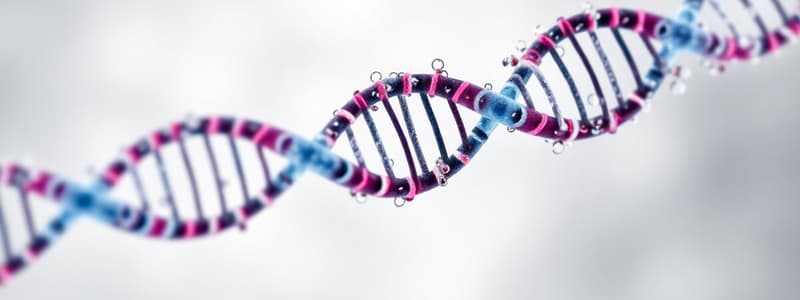Podcast
Questions and Answers
What is the crucial consideration when designing primers for PCR to ensure specificity and avoid primer dimers?
What is the crucial consideration when designing primers for PCR to ensure specificity and avoid primer dimers?
- Ensuring the primers have a high self-complementarity to promote annealing.
- Incorporating inverted repeats within each primer to enhance amplification efficiency.
- Using primers that are significantly longer than the target sequence to increase binding affinity.
- Avoiding complementary sequences at the 3' ends of primer pairs. (correct)
In a PCR, which factor most significantly impacts both the specificity and efficiency of the targeted DNA amplification from a complex sample?
In a PCR, which factor most significantly impacts both the specificity and efficiency of the targeted DNA amplification from a complex sample?
- The concentration of magnesium ions $(\text{Mg}^{2+})$ in proportion to dNTP concentration. (correct)
- The brand of the PCR tubes used.
- The total volume of the reaction mix.
- The number of cycles the PCR undergoes.
Why is a heat-stable DNA polymerase, such as Taq polymerase, essential in PCR?
Why is a heat-stable DNA polymerase, such as Taq polymerase, essential in PCR?
- It reduces the need for precise temperature control, simplifying the PCR process.
- It remains active during the high-temperature denaturation step, allowing for repeated cycles of DNA synthesis. (correct)
- It directly targets and amplifies the DNA sequence of interest, eliminating non-specific amplification.
- It initiates DNA synthesis without the need for primers.
Which of the following considerations is most critical during the DNA extraction and purification phase prior to PCR?
Which of the following considerations is most critical during the DNA extraction and purification phase prior to PCR?
A researcher is designing PCR primers for a highly conserved region within a species' genome but observes non-specific amplification. What is the most effective strategy to improve the specificity of the PCR?
A researcher is designing PCR primers for a highly conserved region within a species' genome but observes non-specific amplification. What is the most effective strategy to improve the specificity of the PCR?
Flashcards
Polymerase Chain Reaction (PCR)
Polymerase Chain Reaction (PCR)
A cell-free method using a heat-stable DNA polymerase to amplify a specific DNA segment from a complex DNA sample.
Primers (Oligonucleotide)
Primers (Oligonucleotide)
Short nucleic acid sequences that serve as the starting point for DNA synthesis, complementary to the ends of the targeted DNA fragment.
Ideal Primer Characteristics
Ideal Primer Characteristics
18-25 base pairs, 40-60% GC content; avoid self-complementary regions and ensure the 3' end doesn't match other primers.
Goal of PCR
Goal of PCR
Signup and view all the flashcards
DNA Extraction & Purification
DNA Extraction & Purification
Signup and view all the flashcards
Study Notes
- The goal of PCR is to identify and detect a specific sequence within a genome.
- A challenge lies in ensuring specificity, as genomes contain numerous other sequences of no interest.
- Another challenge is amplifying the small amounts of DNA present in samples.
Polymerase Chain Reaction
- PCR is a cell-free method.
- It uses a heat-stable DNA polymerase.
- PCR synthesizes copies (amplification) of a small, predetermined DNA segment of interest.
- This occurs within a complex starting DNA material.
Primers (Oligonucleotide)
- Primers are short nucleic acid sequences.
- They act as a starting point for DNA synthesis.
- They are complementary to both ends of the targeted DNA fragment.
- Primer length should be 18-25 base pairs.
- The GC content should be 40-60%.
- The 3' terminal sequence of one primer should not be complementary to any region on the second primer.
- Self-complementary sequences, inverted repeats, and self-complementary sequences should be avoided.
Sample Type
- Any nucleic acid containing samples
DNA Extraction and Purification
- DNA isolation protocols include disruption of the cell wall, cell membrane, and nuclear membrane.
- This releases the DNA into solution, followed by precipitation of DNA.
- This ensures removal of contaminating biomolecules such as proteins, polysaccharides, lipids, phenols, and other secondary metabolites.
Studying That Suits You
Use AI to generate personalized quizzes and flashcards to suit your learning preferences.




